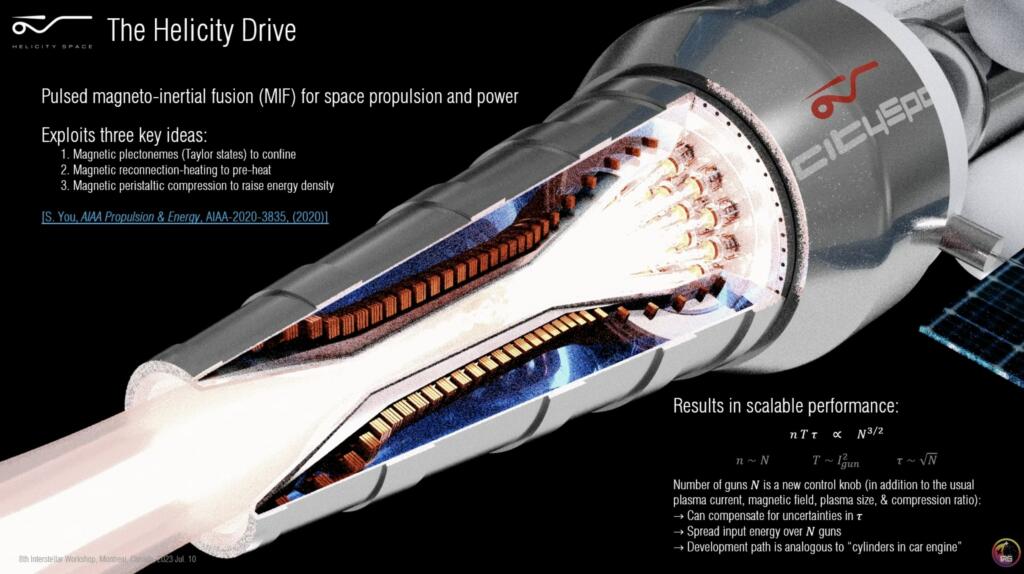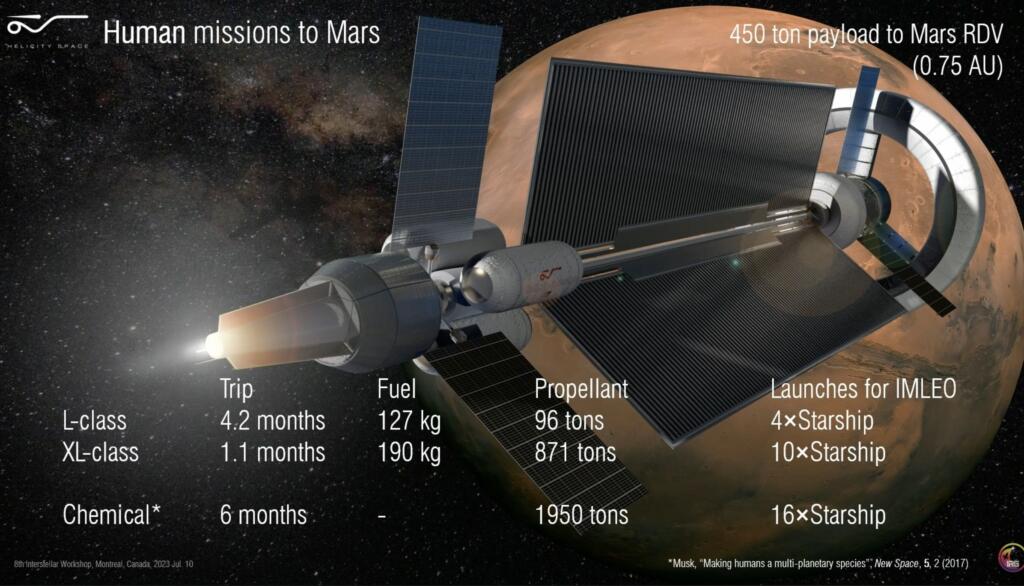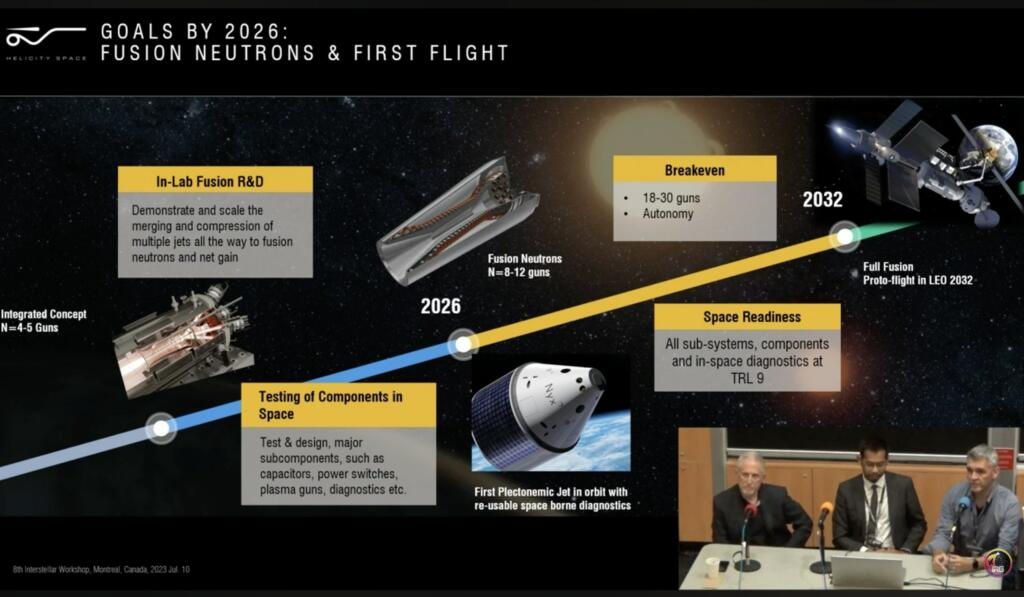There is no need to wait for terrestrial fusion power to begin using fusion propulsion in space. Pushing a spacecraft with short bursts of fusion can be achieved before (and on the way to) producing net electricity every second. Helicity Drive creates a short burst of fusion conditions in a geometry designed for propulsive plasma exhaust, which provides acceleration with every pulse.
Helicity Fusion is developing fusion propulsion for space ships. They have built and are testing their first fusion gun and are testing it in the lab. They plan to have four fusion guns and a compressor by the end of the year. They will NOT reach fusion conditions for a few years. They plan to fly components in space by 2026.
The goal is to have multiple guns reach fusion conditions and have a fusion enabled system flying in space by 2032. They distribute and scale with the number of fusion sources (aka fusion guns).
The systems power and performance will scale with more guns and a higher shot rate. The initial systems will have one shot every 100 seconds and then they will have higher performance with one shot every second.















Brian Wang is a Futurist Thought Leader and a popular Science blogger with 1 million readers per month. His blog Nextbigfuture.com is ranked #1 Science News Blog. It covers many disruptive technology and trends including Space, Robotics, Artificial Intelligence, Medicine, Anti-aging Biotechnology, and Nanotechnology.
Known for identifying cutting edge technologies, he is currently a Co-Founder of a startup and fundraiser for high potential early-stage companies. He is the Head of Research for Allocations for deep technology investments and an Angel Investor at Space Angels.
A frequent speaker at corporations, he has been a TEDx speaker, a Singularity University speaker and guest at numerous interviews for radio and podcasts. He is open to public speaking and advising engagements.


A spacecraft could be accelerated by turning laser-pushed sails into a plasma deep within the throat of a powerful magnetic nozzle.
A laser pushed sail weighing 1 gram, travelling at 20% speed of light, would release energy equivalent to about 1/2 ton of TNT, if it impacted an object.
A small projectile could be shot from the rear of the craft to intercept the fast moving sail as it entered the mag-nozzle turning the sail into a plasma.
You’d get the sails original momentum, plus the expansion of the plasma against the magnetic nozzle field.
Alternativly, an onboard laser might turn the sail into an expanding plasma that pushs against the field, which in turn could charge a capacitor bank to power the next shot, if such a system would weigh less than the “BB gun” set-up.
Why is it that EVERY radical Nuclear In Space idea somehow sidesteps “the elephant in the living room”? Seriously!
The proverbial Elephant in this case is well camouflaged: wrapped up in gossamer fabrics and glitzy ray-traced graphics, The Elephant doesn’t expose even a few hairs of its tail. The Elephant, lest we forget, is “where do these mega-to-giga watts of electricity come from?”
Yes, as naïve sounding an elephant as that, IS the crux of the issue. Their sweet smelling fusion-without-radioactive-fuel pitch is all good and fine, until you ask “what powers this amazing technology in practice?” Ummm … electricity. Lots of it. IF the thruster is decidedly below “unity” (break-even, where the amount of electrical power produced is equal to or larger than the electrical power required to keep it running), as the spiffy graphics end up admitting, then that implies rather large amounts of external power, continuously provided, in order to make up the difference.
After all, “there’s no free lunch” in Physics.
So, then we connect the next dot: where might this extra energy come from? Hmmm… not too many alternatives there, are there. Could be big ol’ honking Solar Panels (“free” energy, without storage, but with mass overhead), could be chemical (one-use batteries, or fuel-cells, conveniently exhausting and lowering the mass of the probe during flight), could be nuclear, as per the radioactive isotope generators on Pioneer and other previously flown spacecraft, or it could be full-blown fission, with penalties for compactness, complexity, reliability … and massive radiation.
Oh, gee. That had to hurt.
Think about it: if the spiffy graphics proclaim that 1 month manned missions to Mars are in the relatively near future, which apparently will require gigawatts of propulion electricity continuously, or WAY more in a pulsed scheme, AND IF that electricity doesn’t come from ground-up Unicorn horns, then it must necessarily come from some enormous reservoir. The enormity of the reservoir seems to have been left out of the total-mass calculations of the Mars Run spacecraft. Completely. Or solved with Magic Bean water.
________________________________________
I’m left with that sad cold feeling that its all a lot of fluff. 5 million bucks isn’t even enough to keep 10 researchers, their experimental crafting plant and their consumables going for even a year. At the end, nothing much to show, except a fruzzy looking physics demonstration, and The Elephant problem remaining unsolved.
The prospect would be a whole lot more tenable if the funding were 100× higher, and the Elephant were the ONLY ISSUE that they were planning to research. I have doubt — but only a modest amount of doubt — that the propulsion physics could be scaled to work in the way they so glibly declare. That’s not the issue. The real issue is that without a power source coupled to the fusion, WAY more productive than “break even”, without that, the whole thing is shît.
So …
⋅-⋅-⋅ Just saying, ⋅-⋅-⋅
⋅-=≡ GoatGuy ✓ ≡=-⋅
Ion drives require an external electricity source too, but somehow we manage to use them in practical spacecraft.
A sub-unity fusion drive is like an ion drive, with some extra power gain from whatever amount of fusion it achieves.
An ion drive is like a fusion drive where Q=0.
Its all about SCALE … and glossy viewgraph projections, Dennis. At the core of ‘my beef’, it is that … completely out-of-scale projections of thrust-might, but without answering the inevitable energy-to-do-it problem.
from Wikipedia: Ion thrusters in operation typically consume 1–7 kW of power, have exhaust velocities around 20–50 km/s (Isp 2000–5000 s), and possess thrusts of 25–250 mN and a propulsive efficiency 65–80%[3][4] though experimental versions have achieved 100 kW (130 hp), 5 N (1.1 lbf).[5]
The Deep Space 1 spacecraft, powered by an ion thruster, changed velocity by 4.3 km/s (2.7 mi/s) while consuming less than 74 kg (163 lb) of xenon. The DAWN spacecraft broke the record, with a velocity change of 11.5 km/s (7.1 mi/s), though it was only half as efficient, requiring 425 kg (937 lb) of xenon.[6]
OK, the point being that that thrust was developed on the DAWN spacecraft from solar panels producing 10 kW of power at Earth’s distance from Sol, and less than ⅛ that between Mars and Jupiter. 11,500 m/s ΔV with 425 kg of Xenon and a huge solar panel array. And it weighed in at about 750 kg — as a probe, all in.
________________________________________
This is not a MANNED interplanetary shuttle by any stretch. Such a vehicle would at the very least require 20 tons or 30× the mass of the Dawn probe. And that … just to get to 11.5 km/s. OK, not impossible. 11.5 km/s (absent the slowing of traversing Sols gravitational field between Earth and Mars) is 105 transit days. This is NOT the 1.1 months envisioned in the most glib viewgraph. Not close.
Such a probe would (probably) be able to aero-brake at Mars to slough off ΔV transit velocity (instead of using Xenon power). And also would split in two parts, with a ‘lander’ separate from the rest. Musk style, the remaining-up-there part might even be coërced to coast back to Earth, largely unpowered. Clearly the 30× × 10 kW solar panels or 300 kW worth, would make all the juice needed.
But to get down to the 1.1 months, would take a ΔV 3× larger, and moreover, developed relatively quickly. This is to counteract the maddening ‘it takes longer to get to high velocity than would have been saved by doing so’ effect. So, 3× the ΔV takes some combination of (more Xenon at the same ISP) and (more ISP for the same Xenon).
The higher ISP in turn requires the SQUARE (E²) of energy. Its the nature of physics … E = ½MV². Higher power, squared, conserves Xenon thruster reaction mass, but at the expense of upping-the-requirement for power, substantially. 9× the power. 9× the 300 kW, so 2,700,000 W of solar power.
The problem there is that that comes with a MASS PENALTY: 9× the solar cells all other things considered, is 9× the mass. Which, frustratingly, acts to retard the ΔV imparted by all that extra energy. Drat!!!
________________________________________
And so on. Perhaps you see the attraction to nuclear power: it is compact, basically trouble-free, long lived (88 year half life!) and doesn’t depend on the distance from Sol for its output. The same 2,700,000 W could be generated with 27 tons of ²³⁸Pu RTG generators, and about the same in thermal radiators to get rid of the heat. Granted, my ‘at least 25 tons’ for the probe has grown to 75+ tons. So, the ΔV would again be thwarted. But the RTGs are inexorable … they keep producing power whether needed or not. Be wary of the ‘if it takes too long to get up to speed’ problem though.
There is no free lunch, in Physics, Dennis. Everything in rocket-science can (literally) be calculated on napkins and using Excel spreadsheets. Everything. All the numeric precision is there, the computational power, all of it. On my 10 year old MacBook Air. Compared to what NASA had to do 50 years back, the ‘computational physics’ problem has been completely solved by cheap consumer devices.
Again, if gigawatts of power are required (per one of the lower viewgraphs), then the Elephant in the Living Room is that those gigawatts have to come from somewhere. Even if the fusion-multiplier effect (what, 10×?) is in effect, then still hundreds of megawatts of injection energy are required. And that is nuclear-power levels of energy.
⋅-⋅-⋅ Just saying, ⋅-⋅-⋅
⋅-=≡ GoatGuy ✓ ≡=-⋅
They never show the front of these fusion spacecraft because there is a fission reactor and shadow shield in the front.